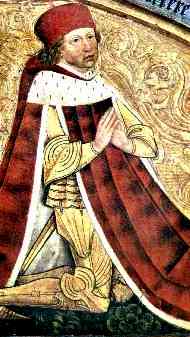Bavarian War (1459–1463) on:
[Wikipedia]
[Google]
[Amazon]
The Bavarian War from 1459 to 1463, also known as the Princes' War, was a result of the expansionist ambitions of the two warring Principalities, pitting Margrave, later Elector, Albert Achilles from the

 Albert Achilles tried to expand the jurisdiction of his courts, as part of his attempt to extend his influence over neighbouring areas. For this purpose, he tried to raise his Burgraviate Court at
Albert Achilles tried to expand the jurisdiction of his courts, as part of his attempt to extend his influence over neighbouring areas. For this purpose, he tried to raise his Burgraviate Court at
House of Hohenzollern
The House of Hohenzollern (, ; , ; ) is a formerly royal (and from 1871 to 1918, imperial) German dynasty whose members were variously princes, Prince-elector, electors, kings and emperors of Hohenzollern Castle, Hohenzollern, Margraviate of Bran ...
, which by this time had already annexed the principalities of Brandenburg-Kulmbach and Brandenburg-Ansbach
The Principality or Margraviate of (Brandenburg) Ansbach ( or ) was a principality in the Holy Roman Empire centered on the Franconian city of Ansbach. The ruling Hohenzollern princes of the land were known as margraves, as their ancestors were ...
, against Duke Louis "the Rich" of Bavaria-Landshut
Bavaria-Landshut () was a duchy in the Holy Roman Empire from 1353 to 1503.
History
The creation of the duchy was the result of the death of Emperor Louis IV the Bavarian. In the Treaty of Landsberg 1349, which divided up Louis's empire, his ...
from the House of Wittelsbach
The House of Wittelsbach () is a former Bavarian dynasty, with branches that have ruled over territories including the Electorate of Bavaria, the Electoral Palatinate, the Electorate of Cologne, County of Holland, Holland, County of Zeeland, ...
.
Background

 Albert Achilles tried to expand the jurisdiction of his courts, as part of his attempt to extend his influence over neighbouring areas. For this purpose, he tried to raise his Burgraviate Court at
Albert Achilles tried to expand the jurisdiction of his courts, as part of his attempt to extend his influence over neighbouring areas. For this purpose, he tried to raise his Burgraviate Court at Nuremberg
Nuremberg (, ; ; in the local East Franconian dialect: ''Nämberch'' ) is the Franconia#Towns and cities, largest city in Franconia, the List of cities in Bavaria by population, second-largest city in the States of Germany, German state of Bav ...
to an Imperial Court. This would have given him jurisdiction over the neighbouring principalities and the possibility to override decisions of subordinate courts. He also had in mind a plan to re-establish the Duchy of Franconia
The Duchy of Franconia () was one of the five stem duchies of East Francia and the medieval Kingdom of Germany emerging in the early 10th century. The word Franconia, first used in a Latin charter of 1053, was applied like the words Francia, Fr ...
, with himself as Duke. The Bishopric of Würzburg
In church governance, a diocese or bishopric is the ecclesiastical district under the jurisdiction of a bishop.
History
In the later organization of the Roman Empire, the increasingly subdivided provinces were administratively associated ...
had similar plans; neither party managed to implement them.
The territory of Duke Louis the Rich of Bavaria-Landshut had recently grown considerably by the incorporation of Bavaria-Ingolstadt.
Alliances
Albert Achilles managed to make a credible case to EmperorFrederick Frederick may refer to:
People
* Frederick (given name), the name
Given name
Nobility
= Anhalt-Harzgerode =
* Frederick, Prince of Anhalt-Harzgerode (1613–1670)
= Austria =
* Frederick I, Duke of Austria (Babenberg), Duke of Austria fro ...
that the Hohenzollern interests in Bavaria happened to coincide with the Imperial interests. After Louis the Rich had created a ''casus belli
A (; ) is an act or an event that either provokes or is used to justify a war. A ''casus belli'' involves direct offenses or threats against the nation declaring the war, whereas a ' involves offenses or threats against its ally—usually one bou ...
'' by taking the Free Imperial City of Donauwörth
Donauwörth (; ) is a town and the capital of the Donau-Ries district in Swabia, Bavaria, Germany. It is said to have been founded by two fishermen where the rivers Danube (Donau) and Wörnitz meet. The city is part of the scenic route called "R ...
, the Emperor outlaw
An outlaw, in its original and legal meaning, is a person declared as outside the protection of the law. In pre-modern societies, all legal protection was withdrawn from the criminal, so anyone was legally empowered to persecute or kill them. ...
ed Louis and tasked Albert Achilles with implementing this verdict.
Both sides drew in allies with different interests and the conflict spread through southern and central Germany and even the Bohemia
Bohemia ( ; ; ) is the westernmost and largest historical region of the Czech Republic. In a narrow, geographic sense, it roughly encompasses the territories of present-day Czechia that fall within the Elbe River's drainage basin, but historic ...
n King George of Poděbrady
George of Kunštát and Poděbrady (23 April 1420 – 22 March 1471), also known as Poděbrad or Podiebrad (; ), was the sixteenth King of Bohemia, who ruled in 1458–1471. He was a leader of the Hussites, but moderate and tolerant toward the ...
participated.
Among Albert Achilles's allies were Margrave Charles of Baden-Baden, Count Ulrich V of Württemberg, his brother Elector Frederick II of Brandenburg, the Electorate of Mainz
The Electorate of Mainz ( or '; ), previously known in English as Mentz and by its French name Mayence, was one of the most prestigious and influential states of the Holy Roman Empire. In the hierarchy of the Catholic Church, the Archbishop-Elec ...
, Duke William III of Saxony
William III (30 April 1425 – 17 September 1482), called the Brave (in German ''Wilhelm der Tapfere''), was landgrave of Thuringia (from 1445) and claimant duke of Luxemburg (from 1457). He is actually the second William to rule Thuringia, an ...
, and Landgrave Louis II of Hesse. Among Louis's allies were Elector Palatine Frederick "the Victorious", also of the House of Wittelsbach, Count Palatine Otto I of Mosbach, and the Prince-Bishop
A prince-bishop is a bishop who is also the civil ruler of some secular principality and sovereignty, as opposed to '' Prince of the Church'' itself, a title associated with cardinals. Since 1951, the sole extant prince-bishop has been the ...
s Rudolf von Scherenberg of Würzburg and Philip of Henneberg of Bamberg, and later also the Bohemia
Bohemia ( ; ; ) is the westernmost and largest historical region of the Czech Republic. In a narrow, geographic sense, it roughly encompasses the territories of present-day Czechia that fall within the Elbe River's drainage basin, but historic ...
n King George of Poděbrady
George of Kunštát and Poděbrady (23 April 1420 – 22 March 1471), also known as Poděbrad or Podiebrad (; ), was the sixteenth King of Bohemia, who ruled in 1458–1471. He was a leader of the Hussites, but moderate and tolerant toward the ...
.
Course of the war
In 1460, it looked like Louis had won: his army had penetrated deep into Albert Achilles's land and forced him to accept the transfer of territory known as the ''Judgement of Roth''. Louis the Rich also attacked theBishopric of Eichstätt
In church governance, a diocese or bishopric is the ecclesiastical district under the jurisdiction of a bishop.
History
In the later organization of the Roman Empire, the increasingly subdivided provinces were administratively associated ...
under Prince-Bishop John III of Eych,
However, in 1461, Albert Achilles had enough allies on his side to be able to reject this judgement. Louis the Rich was still stronger militarily and occupied more land in the Margraviate. The emperor then intervened and tasked the King of Bohemia with negotiating a cease-fire in Prague. Meanwhile, Louis continued to attack neutral cities. He completely destroyed some of them.
Two important battles were fought in 1462: the Battle of Seckenheim in June 1462, where Louis's ally Frederick "the Victorious" managed to take the Imperial captains Charles of Baden-Baden and Ulrich V of Württemberg captive, and the Battle of Geingen, which was won by Louis.
Aftermath
A compromise was reached: Albert Achilles dropped his claims of imperial jurisdiction and Louis returned the territories he had occupied. Further negotiations in Prague led to a peace treaty. The alliances and results of this war are intertwined with other conflicts fought simultaneously in other parts of Germany, such as the Mainz feud.Situation in the Sechsämterland in 1462
An army fromBohemia
Bohemia ( ; ; ) is the westernmost and largest historical region of the Czech Republic. In a narrow, geographic sense, it roughly encompasses the territories of present-day Czechia that fall within the Elbe River's drainage basin, but historic ...
and Cheb
Cheb (; ) is a town in the Karlovy Vary Region of the Czech Republic. It has about 33,000 inhabitants. It lies on the Ohře River.
Before the Expulsion of Germans from Czechoslovakia, expulsion of Germans in 1945, the town was the centre of the G ...
invaded the Sechsämterland in 1462 and caused significant damage by looting and pillaging. The ''Amtmann
__NOTOC__
The ''Amtmann'' or ''Ammann'' (in Switzerland) was an official in German-speaking countries of Europe and in some of the Nordic countries from the time of the Middle Ages whose office was akin to that of a bailiff
A bailiff is a ...
'', Frederick of Dobeneck, at Thierstein Castle set fire to the village of Thierstein to prevent the enemy troops from entrenching in it. Because he had allowed the villagers of Theirstein to seek refuge in the castle, he was unable to resiste a lengthy siege and had to surrender. The Bohemians went on to capture Hohenberg Castle and burned down the city of Weißenstadt.
According to legend, Frederick of Sparneck vowed that he would found a monastery if he would be spared the ravages of war. As he was spared, he founded Sparneck Abbey.
At the Katharinenberg bei Wunsiedel, Jobst of Schirnding managed to drive the Bohemians back, after a six-week unsuccessful siege of the city. The church on the Katharinenberg was destroyed during the siege and has been a ruin ever since. His success was, however, not the result of military strength — the invading armies were far stronger — but due to internal conflicts between the Bohemians and the troops from Eger (Eger region being German speaking and Catholic, while Czech-speaking Bohemians were mostly Hussitic). Several villages in the Eger area were destroyed by the retreating Bohemian army.Elisabeth Jäger: ''Wunsiedel 1163–1560'', Wunsiedel, 1987, p. 242 Local sources distinguish between a "longer" and a "closer" Hussite raid, thus linking the event to the Hussite Wars
The Hussite Wars, also called the Bohemian Wars or the Hussite Revolution, were a series of civil wars fought between the Hussites and the combined Catholic forces of Sigismund, Holy Roman Emperor, Holy Roman Emperor Sigismund, the Papacy, a ...
.
Footnotes
References
* Friedrich Baethgen: ''Schisma und Konilszeit - Reichsreform und Habsburgs Aufstieg'', in: ''Handbuch der deutschen Geschichte'', vol. 6, S, 121-122. * Benno Hubensteiner: ''Bayerische Geschichte'', Munich, 1977, , p. 159-160. * Elisabeth Jäger: ''Wunsiedel 1163–1560'', Wunsiedel, 1987, p. 235-246. * Karl Heinz Kalb: ''Vom Wesen der Kriegsführung am Beginn der Neuzeit - Ihre Auswirkungen am oberen Main'', in: ''Heimatbeilage zum Amtlichen Schulanzeiger des Regierungsbezirks Oberfranken'', Bayreuth, 1977, p. 34-42. * Andreas Kraus (ed.): ''Geschichte Frankens bis zum Ausgang des 18. Jahrhunderts'', in: ''Handbuch der Bayerischen Geschichte'', vol. 3, part 1, Munich, 1997, , p. 435-441. * Johannes Merz und Robert Schuh (ed.): ''Franken im Mittelalter'', Dachau, 2004, p. 310-319. {{DEFAULTSORT:Bavarian War (1459-63) Conflicts in 1459 Conflicts in 1460 Conflicts in 1461 Conflicts in 1463 Wars involving Bavaria